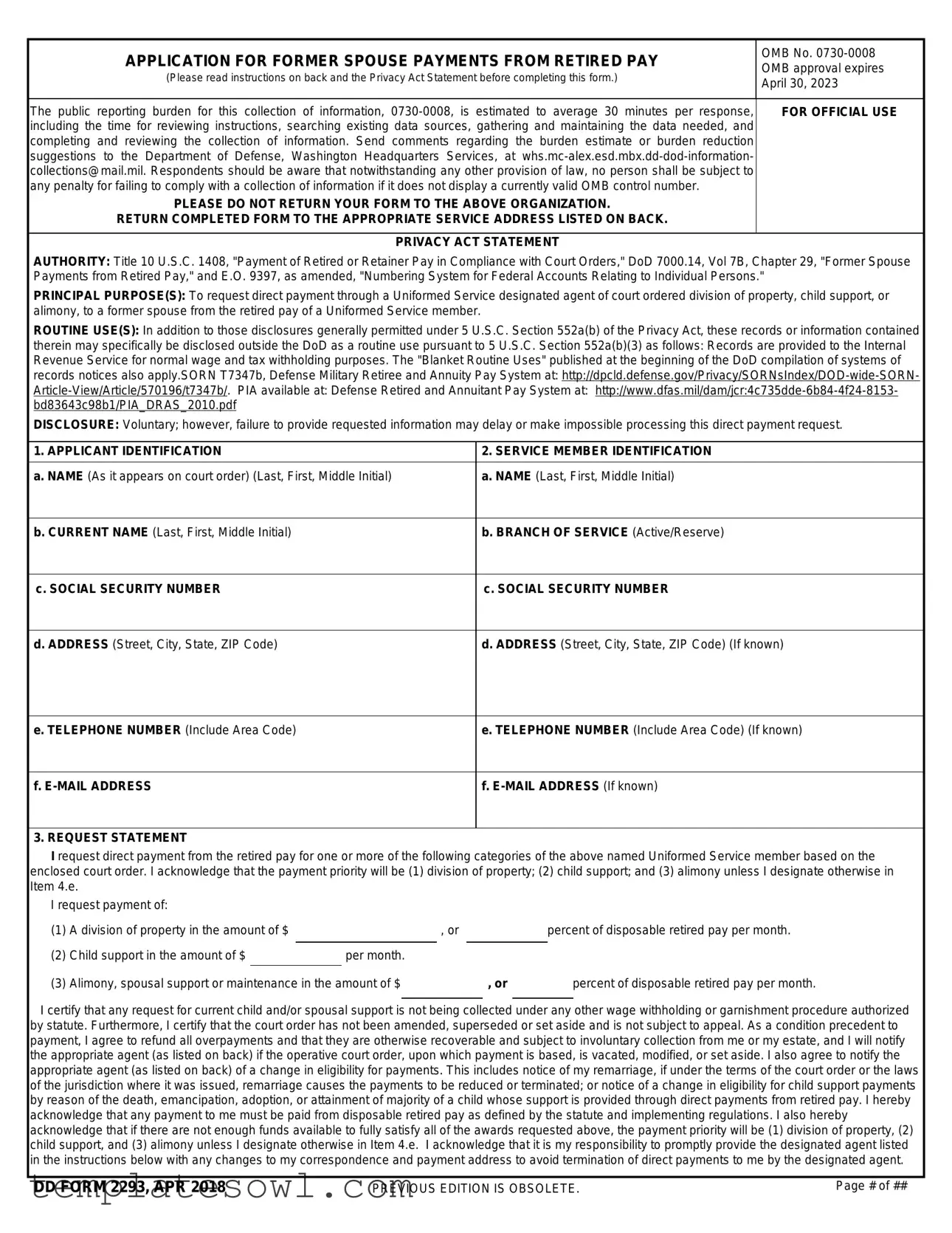
|
APPLICATION FOR FORMER SPOUSE PAYMENTS FROM RETIRED PAY |
OMB No. 0730-0008 |
|
OMB approval expires |
|
(Please read instructions on back and the Privacy Act Statement before completing this form.) |
|
April 30, 2023 |
|
|
|
|
|
The public reporting burden for this collection of information, 0730-0008, is estimated to average 30 minutes per response, |
FOR OFFICIAL USE |
including the time for reviewing instructions, searching existing data sources, gathering and maintaining the data needed, and |
|
completing and reviewing the collection of information. Send comments regarding the burden estimate or burden reduction |
|
suggestions to the Department of Defense, Washington Headquarters Services, at whs.mc-alex.esd.mbx.dd-dod-information- |
|
collections@mail.mil. Respondents should be aware that notwithstanding any other provision of law, no person shall be subject to |
|
any penalty for failing to comply with a collection of information if it does not display a currently valid OMB control number. |
|
PLEASE DO NOT RETURN YOUR FORM TO THE ABOVE ORGANIZATION. |
|
RETURN COMPLETED FORM TO THE APPROPRIATE SERVICE ADDRESS LISTED ON BACK. |
|
|
|
PRIVACY ACT STATEMENT |
|
AUTHORITY: Title 10 U.S.C. 1408, "Payment of Retired or Retainer Pay in Compliance with Court Orders," DoD 7000.14, Vol 7B, Chapter 29, "Former Spouse Payments from Retired Pay," and E.O. 9397, as amended, "Numbering System for Federal Accounts Relating to Individual Persons."
PRINCIPAL PURPOSE(S): To request direct payment through a Uniformed Service designated agent of court ordered division of property, child support, or alimony, to a former spouse from the retired pay of a Uniformed Service member.
ROUTINE USE(S): In addition to those disclosures generally permitted under 5 U.S.C. Section 552a(b) of the Privacy Act, these records or information contained
therein may specifically be disclosed outside the DoD as a routine use pursuant to 5 U.S.C. Section 552a(b)(3) as follows: Records are provided to the Internal Revenue Service for normal wage and tax withholding purposes. The "Blanket Routine Uses" published at the beginning of the DoD compilation of systems of records notices also apply.SORN T7347b, Defense Military Retiree and Annuity Pay System at: http://dpcld.defense.gov/Privacy/SORNsIndex/DOD-wide-SORN- Article-View/Article/570196/t7347b/. PIA available at: Defense Retired and Annuitant Pay System at: http://www.dfas.mil/dam/jcr:4c735dde-6b84-4f24-8153- bd83643c98b1/PIA_DRAS_2010.pdf
DISCLOSURE: Voluntary; however, failure to provide requested information may delay or make impossible processing this direct payment request.
1. APPLICANT IDENTIFICATION |
2. SERVICE MEMBER IDENTIFICATION |
|
|
a. NAME (As it appears on court order) (Last, First, Middle Initial) |
a. NAME (Last, First, Middle Initial) |
b. CURRENT NAME (Last, First, Middle Initial)
b. BRANCH OF SERVICE (Active/Reserve)
c. SOCIAL SECURITY NUMBER
c. SOCIAL SECURITY NUMBER
d. ADDRESS (Street, City, State, ZIP Code)
d. ADDRESS (Street, City, State, ZIP Code) (If known)
e. TELEPHONE NUMBER (Include Area Code)
e. TELEPHONE NUMBER (Include Area Code) (If known)
f. E-MAIL ADDRESS (If known)
3. REQUEST STATEMENT
I request direct payment from the retired pay for one or more of the following categories of the above named Uniformed Service member based on the enclosed court order. I acknowledge that the payment priority will be (1) division of property; (2) child support; and (3) alimony unless I designate otherwise in Item 4.e.
I request payment of:
(1) |
A division of property in the amount of $ |
|
|
, or |
percent of disposable retired pay per month. |
|
|
|
|
|
|
|
|
(2) |
Child support in the amount of $ |
|
per month. |
|
|
|
|
|
|
|
|
, or |
|
(3) |
Alimony, spousal support or maintenance in the amount of $ |
|
percent of disposable retired pay per month. |
I certify that any request for current child and/or spousal support is not being collected under any other wage withholding or garnishment procedure authorized by statute. Furthermore, I certify that the court order has not been amended, superseded or set aside and is not subject to appeal. As a condition precedent to payment, I agree to refund all overpayments and that they are otherwise recoverable and subject to involuntary collection from me or my estate, and I will notify the appropriate agent (as listed on back) if the operative court order, upon which payment is based, is vacated, modified, or set aside. I also agree to notify the appropriate agent (as listed on back) of a change in eligibility for payments. This includes notice of my remarriage, if under the terms of the court order or the laws of the jurisdiction where it was issued, remarriage causes the payments to be reduced or terminated; or notice of a change in eligibility for child support payments by reason of the death, emancipation, adoption, or attainment of majority of a child whose support is provided through direct payments from retired pay. I hereby acknowledge that any payment to me must be paid from disposable retired pay as defined by the statute and implementing regulations. I also hereby acknowledge that if there are not enough funds available to fully satisfy all of the awards requested above, the payment priority will be (1) division of property, (2) child support, and (3) alimony unless I designate otherwise in Item 4.e. I acknowledge that it is my responsibility to promptly provide the designated agent listed in the instructions below with any changes to my correspondence and payment address to avoid termination of direct payments to me by the designated agent.
DD FORM 2293, APR 2018 |
PREVIOUS EDITION IS OBSOLETE. |
Page # of ## |

4.I HAVE ENCLOSED ALL PERTINENT DOCUMENTATION TO INCLUDE: (Check as applicable)
a.A copy of the operative court order and other accompanying documents that provide for payment of division of retired pay as property, child support, or alimony, containing a certification dated by the clerk of the court within 90 days preceding the date the application is received by the designated agent. (See Item 4 instructions below.)
b.Evidence of the date(s) of my marriage to the member if the application is for the direct payment of a division of the member's disposable retired pay as property (i.e., a copy of the marriage certificate, or a court order that shows the date of marriage).
c. If payment request includes child support, give name(s) and birth date(s) of child(ren):
(1) NAME OF CHILD (Last, First, Middle Initial) |
(2) DATE OF BIRTH (YYYYMMDD) |
|
|
|
|
|
|
|
|
|
|
|
|
d. If applying under Title 10 U.S.C. 1408(h), Dependent Victims of Abuse provision, in addition to 4.a. above, enclose both a copy of the member's court martial order and the member's statement of service.
e. Other information (please identify) or remarks.
5a. APPLICANT'S SIGNATURE (The form must be signed by a spouse or former spouse and not the member or attorney.)
b. DATE SIGNED (YYYYMMDD)
INSTRUCTIONS FOR COMPLETION OF DD FORM 2293
GENERAL. These instructions govern an application for direct payment from retired pay of a Uniformed Service member in response to court ordered division of property, child support, or alimony, under the authority of 10 USC 1408.
SERVICE OF APPLICATION. You may serve the application by mail on the appropriate Uniformed Service designated agent. The Uniformed Services' designated agents are:
(1)ARMY, NAVY, AIR FORCE, AND MARINE CORPS: DFAS Office of General Counsel, Attn: Garnishment Law Directorate, P.O. Box 998002, Cleveland, OH 44199-8002 Application may also be served by fax to 877-622-5930 (toll-free) or (216)367-3675.
(2)COAST GUARD: Commanding Officer (LGL), United States Coast Guard, Pay and Personnel Center, 444 S.E. Quincy Street, Topeka, KS 66683-3591. Application may also be served by fax to 785-339-3788.
(3)NATIONAL OCEANIC AND ATMOSPHERIC ADMINISTRATION: Same as U.S. Coast Guard.
(4)PUBLIC HEALTH SERVICE: Commanding Officer (LGL), United States Coast Guard, Pay and Personnel Center, 444 S.E. Quincy Street, Topeka, KS, 66683-3591. Application may also be served by fax to 785-339-3788.
IMPORTANT NOTE: Making a false statement or claim against the United States Government is punishable. The penalty for willfully making a false claim or false statement is a maximum fine of $10,000 or maximum imprisonment of 5 years or both (18 USC 287 and 1001).
|
ITEM 1. |
|
ITEM 4. A certified copy of a court order can be obtained from the court that |
|
a. Enter full name as it appears on the court order. |
|
issued the court order. Other documents include, but are not limited to, final |
|
b. Enter current name if different than it appears on court order. |
divorce decree, property settlement order, and any appellate court orders. If the |
|
c. Enter Social Security Number. |
|
court order does not state that the former spouse was married to the member |
|
d. Enter current address. |
|
for ten years or more while the member performed ten years creditable service |
|
e. Enter telephone number. |
|
and the request is for payment of a division of property, the applicant must |
|
f. Enter e-mail address, if applicable. |
|
provide evidence to substantiate the ten years' marriage condition. Additional |
|
ITEM 2. |
|
evidence must show that the ten years' requirement has been met, including: |
|
|
Uniformed Service orders, marriage certificate, and other documents that |
|
a. Enter member's full name as it appears on the court order. |
|
establish the period of marriage. In addition, if the court order does not indicate |
|
b. Enter member's branch of service. |
|
the date of divorce, then you need to submit a copy of the divorce decree. |
|
c. Enter member's Social Security Number. |
|
Other information or documents included with the request should be clearly |
|
d. Enter member's current address, if known. |
|
identified by the document's title and date. Remarks may be provided to clarify |
|
e. Enter member's telephone number, if known. |
|
specific points. |
|
|
f. Enter member's email address, if known. |
|
ITEM 5. Read the Acknowledgement carefully, as it contains language stating |
|
ITEM 3. Read the Request Statement carefully, as it contains language stating |
|
that you"acknowledge" to keep us informed of any change of correspondence |
|
that you "certify and acknowledge". |
|
and payment address. Failure to apprise DFAS of address changes may result |
|
|
|
in the suspension or termination of payments. |
|
|
|
|
ITEM 6a. Applicant's signature required. The form may not be signed by a |
|
|
|
member or attorney. |
|
|
|
|
|
|
|
DD FORM 2293, APR 2018 |
PREVIOUS EDITION IS OBSOLETE. |
Page # of ## |


